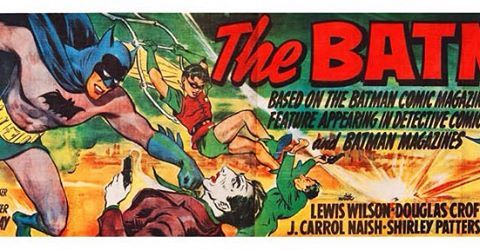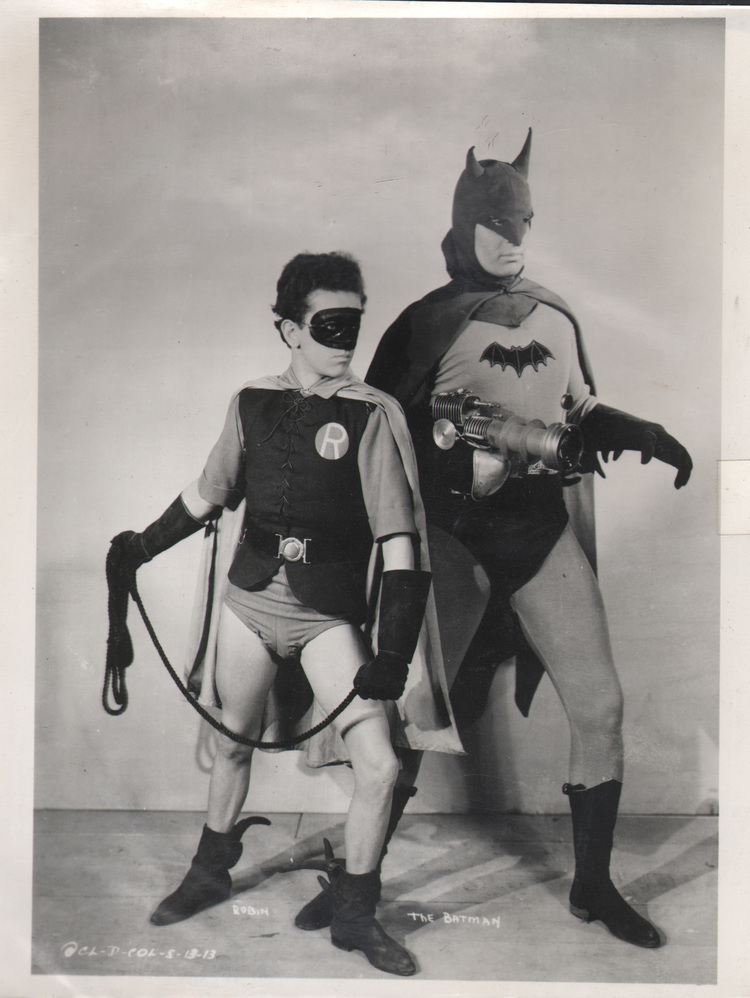There were two Batman serials from Columbia Pictures-- the first, called THE BATMAN stars Lewis Wilson as Batman and Doug Croft as Robin. The serial is often maligned for having racist overtones but it was filmed at the height of WWII in spring of 1943 when it looked like we might actually lose the war and only two years after the Japanese had launched a sneak attack on Pearl Harbor plunging the US into the war.
The serial itself originally was going to feature The Joker running his crime operation from a circus sideshow cover, but when the World War II angle was added and they opted to create a Batman adversary not of criminal intent but of an Axis spy ring DC Comics objected to Joker being connected to it (during the war being against the country was worse than being a homicidal killer) so the villain was changed to Dr Daka. Early serial posters seem to indicate that the actor playing Daka was set to play the Joker as well.

Daka's costume and whiteish skin coloring in the film as well as the fact that he appears to be wearing lipstick leads me to believe they changed very little when the opted to go from Joker to Japanese spy.
The second serial, done in 1949 was ADVENTURES OF BATMAN AND ROBIN and was created after the big success Columbia had with SUPERMAN a year earlier. Initial plans were for Superman actor Kirk Alyn to play Batman this time and John Duncan stated that the costume was done for Alyn's measurements. When Alyn backed out, fearing the typecasting of playing two superheroes Robert Lowery was brought in. Lowery was a bit shorter, and that's why the costume doesn't seem to fit-- the bat emblem is lower, almost on his stomach, and he constantly has to tilt his head back so he can see through the eye slits in his mask.
So how do these serials connect to the Adam West show?
CBS had optioned BATMAN as a TV series in 1964, even going so far as to sign former LA Ram Mike Henry (Mike was soon to take over the Tarzan role in movies) to star and rumors persist that he was photographed in a Batman suit to generate interest in the property but those photos have never surfaced. The project would have been a serious Batman show along the lines of THE LONE RANGER and ADVENTURES OF SUPERMAN and DC Comics was hot to have their characters on TV. The Superman show had helped boost the comic sales, and they'd hoped the same would be true with Batman.
CBS lost interest and the development went into limbo, the property was presented to NBC who passed and eventually ended up at ABC.
Meanwhile, in July of 1965 the Playboy Theater in Chicago started showing an episode of the Batman serial on weekends along with it's art house films, and reaction was strong. In the fall of '65 Hugh Hefner strung all 15 chapters of the serial together and showed it as AN EVENING WITH BATMAN AND ROBIN and it drew in huge crowds of movie buffs and college kids. Columbia took note of the record breaking attendance and created the same package which it offered to small theaters all over the country.
Theaters across the country, especially art house theaters that were showing things like Humphrey Bogart revivals and the like, were doing equally popular business.
Now here's where the connection gets fuzzy. ABC was developing the show, and had turned it over to Dozier who in turn hired Lorenzo Semple to write the pilot and the series bible-- Semple has said in interviews that he began work in mid-1965 on the script so the rumors that showings of the serial at the Playboy Club influenced ABC executives in the audience to want to develop a new show are false-- ABC already had the property-- but what likely happened is the positive reaction helped to entice them to make sure it happened, and it built the growing Batmania that would cause the pre-release of the show publicity to build to a fevered point that ensured the pilot would be a big hit in January 1966.
Regardless of the impact, it was clear Semple and Dozier were at least aware of the serials because that was the impetus for breaking the planned hour long show into two half hour parts with a cliffhanger between them, mimicking the weekly serials.



